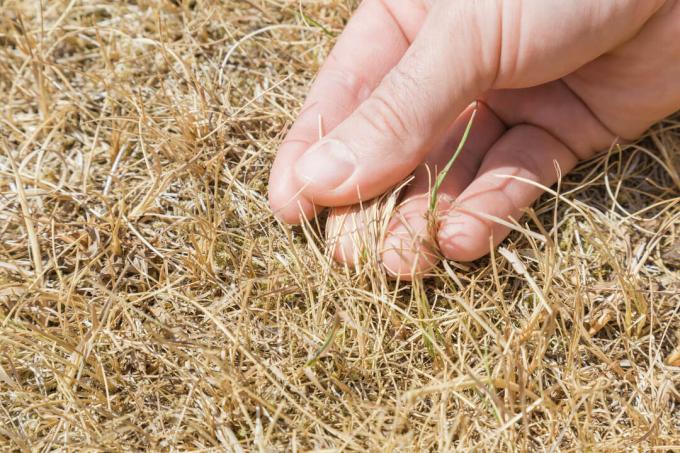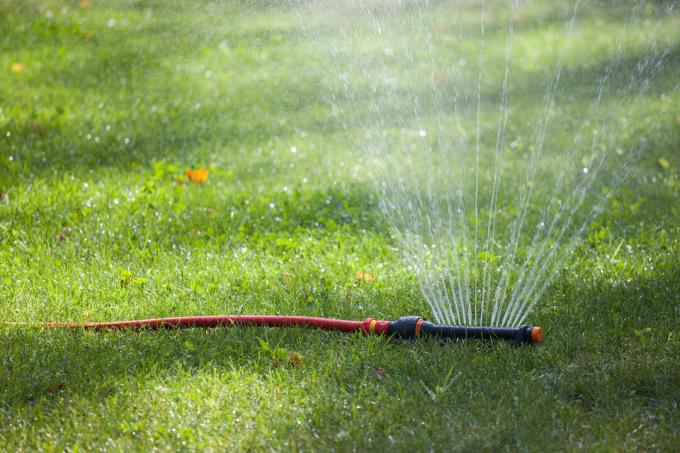Heat, sun, lack of water – our lawn has to put up with a lot in summer. But with these tips, your brown lawn will become a green carpet again.

In recent years there have been a number of hot and dry drought summers. Instead of a dreamy green lawn, you saw burned, brown grass and bare spots in many places. No wonder - the extreme heat coupled with too little water is far outside the optimal living conditions for lawn grasses. The only thing that helps is waiting and hoping for the best, right? Wrong thought! We'll show you four simple tricks to get your lawn back in top shape.
contents
- Why is the lawn "burnt" in the summer?
- Tip 1: Water the lawn
- Tip 2: Use autumn lawn fertilizer
- Tip 3: Protect the lawn
- Tip 4: Reseed the lawn
Why is the lawn "burnt" in the summer?
Even if it may seem so because of the heat and drought, the lawn is of course not actually burned.
Rather, the yellowing and browning of the area is a protective mechanism of the grasses, which is referred to as heat dormancy. Dormancy means a resting phase with reduced metabolic activity, similar to a "summer sleep" into which the grasses go. They then pull all reserve substances from the stalks back into the roots and wait for better times with less heat and a larger supply of water.
If you see your lawn turning yellow in summer, you don't have to worry about the existence of the lawn. But it may well be that more sensitive grasses like this German ryegrass (Lolium perenne) do not survive the dry phase and in the following spring by a overseeding have to be added again.

Tip: Optimum growth conditions for lawn grass are around 22 - 25 °C with sufficient moisture and plenty of light. Above 30 °C, however, all life processes are reduced to a minimum.
Tip 1: Water the lawn
It sounds trite, but the most important step to saving a brown lawn (or preventing it from turning brown in the first place) is watering it properly. Finally, lack of water is one of the main reasons that leads to brown lawns. A lawn sprinkler is best suited for watering: This not only distributes the water evenly over the lawn, but also saves you from having to carry it around. When watering the lawn, it is better to water less frequently and more thoroughly. In summer, a lawn should only be watered once or twice a week with 15 liters per square meter. How you the water the lawn properly, you can find out in our special article.

Tip 2: Use autumn lawn fertilizer
What does lawn fertilization in autumn have to do with a green lawn in summer? The answer is simple: fall lawn fertilizers usually contain more potassium than spring and summer fertilizers. In addition to frost tolerance, potassium also improves the efficiency of water absorption and the stability of cell walls, so that less water can escape through them and be lost by the grasses. Potassium-rich autumn lawn fertilization is already the preparation for a green lawn next summer. For a green and environmentally friendly lawn, rely on organic certified autumn lawn fertilizers like ours Plantura Organic Autumn Lawn Fertilizer. In addition, with this choice you protect all pets and garden animals and support a healthy soil life. After fertilizing, you should then water the lawn so that the nutrients are released soon and reach the roots. Incidentally, the best time for autumn lawn fertilization is late summer at the latest September so that the lawn grass still has enough time to absorb the nutrients it contains to appropriate

The advantages of the Plantura organic autumn lawn fertilizer at a glance:
- Extra dose of potassium ensures improved winter hardiness and drought tolerance
- Long-term available nitrogen for fast and healthy growth in spring
- The organic recipe protects the environment and all pets and garden animals
- The purely vegetable fertilizer granules support healthy soil life
- Lawn can be stepped on again by humans and animals immediately after fertilization
- Easy to dose
tip: Indirectly, spring fertilization is already an important prophylaxis for a green lawn in summer. Because if the roots can grow vigorously in the spring thanks to a good supply of nutrients, you can supply the grass with water better in the summer. Therefore, you should also use organic lawn fertilizers in spring, as these encourage the roots to grow better.
Tip 3: Protect the lawn
Playing football, romping around or having a relaxing picnic: a lawn is good for many things. However, if your lawn is dry and brown, the saying goes: rest is the best medicine. Because with every step, the already stressed turf is further damaged and thus loses its health and regenerative power. So try to protect your lawn as much as possible. This also means: A lawn that does not grow or is even yellowish does not have to and should not be mowed.

Tip: In general, when mowing the lawn in warm and hot summers, the grass can be left longer than in spring and autumn. The longer the lawn, the less sun hits the ground and the less water evaporates - so a slightly longer lawn is a real water-saving trick that is good for the grass.
Tip 4: Reseed the lawn
Sometimes all efforts are not enough and despite watering, fertilizing and care, the lawn does not return to its old form. It can also happen that the lawn only partially recovers - particularly "burned" areas remain as ugly stains in the otherwise green turf. If damage becomes visible on a large scale in autumn or spring, there is only one thing left to do: sow the lawn again. If you want to derive a forward-looking action from the hot summers, you can use dry grass directly. Dry grass mixes like ours Plantura dry grassland contain grass species that are better adapted to drought, such as tall fescue (Festuca arundinacea) and meadow grass (Poa pratensis). Our premium seeds only use RSM-certified varieties, which ensures a high germination rate with healthy grasses.
A particularly good time for sowing is after scarifying in spring, as the soil is then open, the seed can absorb well and competitors such as moss and weeds are eliminated. If you are very impatient, you can reseed in autumn by the end of October at the latest and thus forestall weeds in the lawn. Why exactly one scarify the lawn should and how to proceed, you can find out in our special article.

